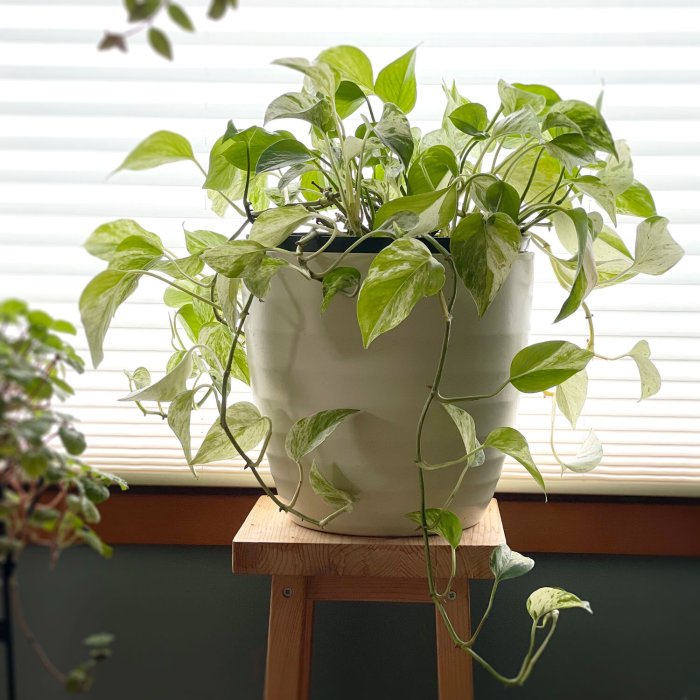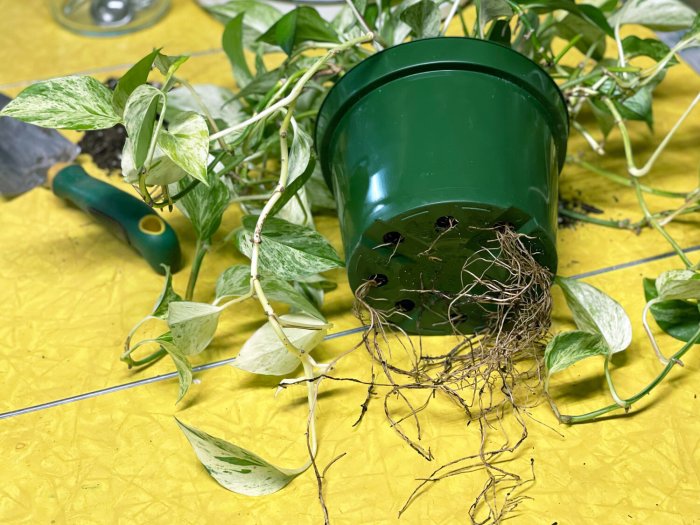Can you repot hanging plants? The answer is a resounding yes! Repotting hanging plants is a crucial aspect of their care, ensuring their optimal growth and well-being. Whether you’re a seasoned plant enthusiast or a novice gardener, this comprehensive guide will provide you with all the essential information you need to successfully repot your hanging plants.
From selecting the right plants and pots to preparing the soil and repotting techniques, we’ll cover every step of the process in detail. Additionally, we’ll delve into hanging and care tips, troubleshooting common problems, and advanced techniques to enhance your hanging plant’s health and beauty.
Plant Selection and Preparation

Repotting hanging plants is a crucial step in maintaining their health and growth. The selection of the right plants and proper preparation techniques ensure a successful repotting process.
Suitable Hanging Plants
- Pothos
- Spider plant
- String of pearls
- Burro’s tail
- Ferns
Ideal Plant Size and Condition
For repotting, choose plants that are healthy and have outgrown their current pots. The root system should be well-developed but not overly crowded or pot-bound.
Root Pruning and Trimming
Before repotting, gently remove the plant from its current pot and inspect the roots. If necessary, prune any excessively long or damaged roots. Trim off any dead or decaying roots.
Choosing the Right Pot

Selecting the appropriate pot for your hanging plant is crucial to ensure its health and aesthetics. Consider the plant’s size, growth habit, and watering needs when choosing a pot.
Repotting hanging plants can be a simple way to give them a fresh start and keep them healthy. When choosing a new pot, it’s important to consider the size, shape, and material. Bunnings wall hanging pots offer a wide range of options, from classic terracotta to modern ceramic.
Once you’ve selected the perfect pot, carefully remove the plant from its old container and gently loosen the roots. Place the plant in the new pot and fill it with fresh potting mix, tamping down gently to remove any air pockets.
Water the plant thoroughly and allow it to drain before hanging it back up.
The pot should be large enough to accommodate the plant’s roots without being too spacious, as this can lead to overwatering. Opt for a pot that is 2-4 inches wider than the root ball.
Pot Material
- Terracotta:Porous, allows for good drainage but can dry out quickly.
- Plastic:Lightweight, durable, and retains moisture well.
- Ceramic:Non-porous, retains moisture and adds weight to the pot.
- Metal:Durable, but can heat up in the sun and require extra drainage.
Drainage Holes
Drainage holes are essential for preventing root rot. Ensure that the pot has multiple drainage holes at the bottom to allow excess water to escape.
Aesthetics
The pot’s style should complement the plant and your home decor. Consider the shape, color, and texture of the pot when making your selection.
Soil Preparation and Repotting Procedure

Preparing the soil and repotting hanging plants is crucial for their health and growth. The right potting mix and repotting technique ensure optimal drainage, aeration, and nutrient availability.
Potting Mix Recipe
For well-draining soil, mix the following ingredients:
- 1 part peat moss
- 1 part perlite
- 1 part compost or bark
Repotting Procedure
Follow these steps to repot a hanging plant:
- Remove the plant from the old pot by gently squeezing the sides and inverting it.
- Loosen the roots by gently untangling them with your fingers or a fork.
- Place the plant in the new pot and fill it with the prepared potting mix, leaving about an inch of space at the top.
- Firmly pack the soil around the plant to secure it.
- Water the plant thoroughly and allow the excess water to drain.
Watering and Fertilizing
After repotting, water the plant regularly to keep the soil moist but not soggy. Allow the top inch of soil to dry out before watering again.
Fertilize the plant monthly during the growing season with a balanced liquid fertilizer diluted to half strength.
Hanging and Care Tips

After repotting, it’s crucial to hang and care for your plant properly to ensure its well-being.
Repotting hanging plants can be a daunting task, but with the right tools and techniques, it can be done successfully. If you’re looking for a convenient and low-maintenance option, consider self watering hanging baskets bunnings . These baskets feature a built-in reservoir that automatically waters your plants, making it easy to keep them healthy and thriving.
Whether you’re a seasoned gardener or just starting out, repotting hanging plants can be a rewarding experience.
Hanging the Plant, Can you repot hanging plants
Hang the plant at an appropriate height, considering its size and the length of its trailing stems. Use sturdy hooks or brackets to support the plant’s weight.
Lighting Requirements
Different hanging plants have varying light requirements. Ensure you research the specific plant’s needs and provide adequate lighting. Bright indirect light is generally suitable for most hanging plants.
If you’re looking to add some greenery to your home, hanging plants are a great option. They can add a touch of life to any room, and they’re relatively easy to care for. But what if you want to repot your hanging plant? Is it possible? The answer is yes, you can repot hanging plants.
However, there are a few things you need to keep in mind. First, you’ll need to choose the right pot. For bunnings hanging succulents , a pot with drainage holes is essential. Second, you’ll need to use a well-draining potting mix.
Third, you’ll need to be careful not to overwater your plant. With a little care, you can successfully repot your hanging plant and enjoy it for years to come.
Watering
Water the plant thoroughly after repotting. Allow the excess water to drain before hanging the plant. Water regularly, ensuring the soil remains moist but not waterlogged. Overwatering can lead to root rot.
Common Pests and Diseases
Hanging plants are susceptible to common pests like aphids, mealybugs, and spider mites. Regularly inspect the plant for signs of infestation. Treat pests promptly with appropriate insecticides or neem oil. Diseases such as powdery mildew and botrytis can also occur.
Provide good air circulation and avoid overwatering to prevent fungal diseases.
Troubleshooting and Advanced Techniques
Repotting hanging plants can be a rewarding experience, but it’s not without its challenges. Here are some common problems that may arise during or after repotting, along with tips for advanced techniques:
Root Rot
Root rot is a common problem that can occur when hanging plants are overwatered. The roots of the plant become waterlogged and begin to rot, which can eventually lead to the death of the plant. To prevent root rot, make sure to allow the soil to dry out between waterings and avoid overwatering.
Transplant Shock
Transplant shock is a condition that can occur when hanging plants are repotted. The plant may wilt, drop leaves, or even die. To minimize transplant shock, handle the roots of the plant carefully when repotting and water the plant thoroughly after repotting.
Self-Watering Hanging Planters
Self-watering hanging planters are a great way to keep your plants watered while you’re away. These planters have a reservoir that holds water, which is then wicked up into the soil as needed. This helps to prevent overwatering and ensures that your plants get the water they need.
Propagating Hanging Plants from Cuttings
Propagating hanging plants from cuttings is a great way to create new plants for free. To propagate a hanging plant from a cutting, simply take a cutting from the stem of the plant and place it in a glass of water.
The cutting will eventually develop roots, and once it has developed enough roots, you can transplant it into a pot.
Hanging Plant Hooks, Brackets, or Chains
There are a variety of different hanging plant hooks, brackets, or chains that you can use to hang your plants. The type of hook or bracket that you choose will depend on the weight of the plant and the location where you want to hang it.
Summary: Can You Repot Hanging Plants
Repotting hanging plants is a rewarding endeavor that can transform your indoor or outdoor space into a vibrant oasis. By following the steps Artikeld in this guide, you can ensure your hanging plants thrive and bring joy to your surroundings for years to come.
So, gather your gardening tools, choose your favorite hanging plants, and embark on the fulfilling journey of repotting your hanging plants today!
Questions and Answers
How often should I repot my hanging plants?
Repotting frequency depends on the growth rate and size of your hanging plants. As a general rule, repot every 1-2 years or when the roots become pot-bound.
What type of soil is best for hanging plants?
Hanging plants prefer well-draining potting mixes. A mixture of peat moss, perlite, and vermiculite is a good option.
How do I water my hanging plants after repotting?
Water thoroughly after repotting and allow excess water to drain. Avoid overwatering, as this can lead to root rot.